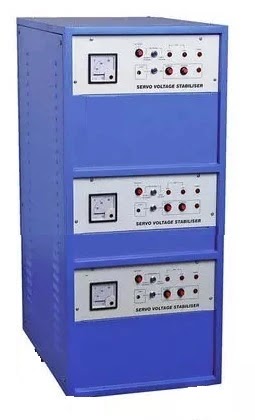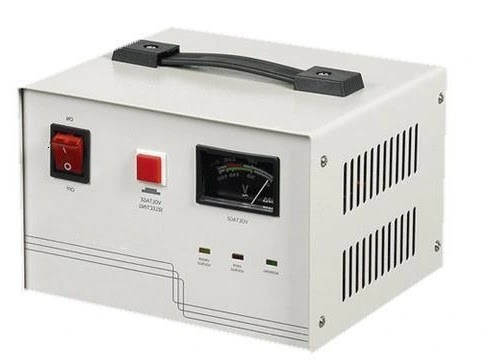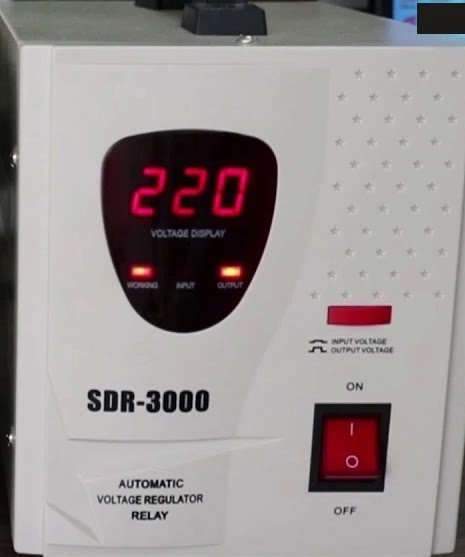Voltage Stabilizer | Voltage Stabilizer for home | Servo Voltage Stabilizer | Voltage Stabilizer Rating Calculator | Automatic Voltage Stabilizer | AC Voltage Stabilizer
AC Voltage stabilizers are devices that help regulate the voltage of an electrical system. They are used to protect appliances and devices from voltage fluctuations, which can cause damage and reduce the lifespan of equipment. In this article, we will discuss what a voltage stabilizer is, how it works, and its benefits.
What is a Voltage Stabilizer?
A voltage stabilizer is an electronic device that is used to regulate the voltage of an electrical system. It is designed to maintain a constant voltage level, regardless of the input voltage fluctuations. The voltage stabilizer can be used for different types of appliances, including air conditioners, refrigerators, televisions, and other household and industrial equipment.
How Does a Voltage Stabilizer Work?
A voltage stabilizer works by continuously monitoring the input voltage of the electrical system. If the input voltage fluctuates beyond a preset range, the voltage stabilizer adjusts the output voltage to maintain a stable voltage level. The voltage stabilizer uses a transformer and other electronic components to regulate the voltage level.
Types of Voltage Stabilizers
There are two main types of voltage stabilizers: manual and automatic. Manual voltage stabilizers are designed to be adjusted manually by the user. They are less expensive but require the user to monitor the voltage levels constantly. Automatic voltage stabilizers, on the other hand, adjust the voltage automatically without any user intervention.
Block diagram of Voltage Stabilizer
The block diagram of a voltage stabilizer typically consists of the following components:
Voltage Sensing Circuit: This circuit senses the input voltage of the electrical system and compares it to a reference voltage. The output of this circuit is used to control the voltage regulation circuit.
Voltage Regulation Circuit: The voltage regulation circuit is responsible for regulating the output voltage of the voltage stabilizer. It adjusts the voltage level using a transformer or other electronic components to maintain a constant output voltage level.
Control Circuit: The control circuit receives the output of the voltage sensing circuit and uses it to adjust the output voltage of the voltage regulation circuit. The control circuit may also include a microcontroller or other intelligent control system for more advanced regulation.
Output Circuit: The output circuit delivers the stabilized voltage to the electrical system. It may include additional filtering and protection components to ensure a stable and clean voltage output.
Selection guide of Voltage stabilizer for home
When selecting a voltage stabilizer for home use, there are several factors to consider to ensure you choose the right one for your needs. Here are some of the key factors to consider:
Voltage range: The first factor to consider is the voltage range of the stabilizer. The stabilizer should be able to handle the range of voltages that your home experiences, including both high and low voltages.
Capacity: The capacity of the voltage stabilizer should match the total power consumption of the appliances and devices that you want to protect. A voltage stabilizer that is too small will not be able to handle the load, while one that is too large will be inefficient.
Type of stabilizer: There are two types of voltage stabilizers, manual and automatic. Manual stabilizers require manual adjustment to regulate the voltage, while automatic stabilizers adjust the voltage automatically. Automatic stabilizers are more convenient and offer better protection.
Brand and quality: It is important to choose a reputable brand and high-quality voltage stabilizer to ensure reliable and efficient performance.
Warranty: A good warranty is an important factor to consider when selecting a voltage stabilizer. A warranty provides peace of mind and ensures that you are protected in case of any issues with the stabilizer.
Safety Factor
When selecting a voltage stabilizer for your application, it is important to consider the safety factor in addition to the electrical specifications of the equipment. A safety factor is a multiplier that is applied to the required rating of the voltage stabilizer to account for any potential variations or fluctuations in the input voltage.
Here are some factors to consider when selecting a safety factor for your voltage stabilizer:
Voltage fluctuations: The safety factor should be large enough to accommodate any expected voltage fluctuations in the electrical system. Voltage fluctuations can occur due to a number of factors, such as power grid instability, lightning strikes, or sudden changes in load.
Load type: Different types of loads may require different safety factors. For example, electronic equipment may be more sensitive to voltage fluctuations than mechanical equipment, so a higher safety factor may be required for electronic loads.
Equipment sensitivity: The safety factor should also consider the sensitivity of the equipment being protected by the voltage stabilizer. More sensitive equipment may require a higher safety factor to ensure that the voltage remains within safe operating limits.
Environment: The safety factor should also consider the environmental conditions where the voltage stabilizer will be installed. For example, if the voltage stabilizer will be installed in a location with high levels of electrical noise or interference, a higher safety factor may be required to ensure that the voltage remains stable.
Manufacturer recommendations:
It is important to consider any recommendations or guidelines provided by the manufacturer of the voltage stabilizer. The manufacturer may provide a recommended safety factor based on the specific application and equipment being protected.
In general, a safety factor of 1.5 to 2 is typically recommended for most applications. However, this can vary depending on the specific factors outlined above. It is important to carefully consider the electrical requirements of your equipment and the environmental conditions where the voltage stabilizer will be installed to determine the appropriate safety factor for your application.
Benefits of Using a Voltage Stabilizer
Protects Appliances: Voltage stabilizers protect appliances and devices from voltage fluctuations, which can cause damage and reduce the lifespan of equipment.
Improves Equipment Performance: Voltage stabilizers ensure that electrical equipment receives a constant voltage level, which helps improve their performance.
Reduces Energy Consumption: Voltage stabilizers help reduce energy consumption by eliminating voltage spikes and surges, which can waste energy.
Increases Safety: Voltage stabilizers can prevent electrical fires and other accidents by regulating the voltage level of the electrical system.
Voltage stabilizer Vs UPS
Voltage stabilizers and uninterruptible power supplies (UPS) are two different types of equipment used to protect electronic devices from voltage fluctuations and power outages. While they both perform similar functions, they have different features and are used in different situations.
Here are some key differences between voltage stabilizers and UPS:
Function: Voltage stabilizers are designed to regulate the voltage level of incoming power, ensuring that the voltage remains within a safe operating range. UPS, on the other hand, provide backup power in the event of a power outage, allowing electronic devices to continue functioning for a period of time.
Protection: Voltage stabilizers protect electronic devices from voltage fluctuations, but they do not provide any protection in the event of a power outage. UPS, on the other hand, protect electronic devices from both voltage fluctuations and power outages.
Capacity: Voltage stabilizers are typically used to protect individual electronic devices or small groups of devices. UPS, on the other hand, are designed to provide backup power to an entire system or network.
Cost: Voltage stabilizers are generally less expensive than UPS, as they do not include backup power capabilities.
Complexity: UPS are generally more complex than voltage stabilizers, as they include additional features such as battery backup, automatic voltage regulation, and surge protection.
voltage stabilizers and UPS perform different functions and are used in different situations. Voltage stabilizers are ideal for protecting individual electronic devices or small groups of devices from voltage fluctuations, while UPS are ideal for providing backup power to an entire system or network in the event of a power outage.
Voltage Stabilizer how Protects from Voltage surges?
Voltage stabilizers protect electronic devices from voltage surges by regulating the voltage level of incoming power. When the voltage level of incoming power exceeds the safe operating range of electronic devices, voltage stabilizers automatically adjust the voltage level to maintain a stable output voltage.
There are different types of voltage stabilizers available in the market, including servo voltage stabilizers, static voltage stabilizers, and automatic voltage regulators. Each type of voltage stabilizer works differently to protect electronic devices from voltage surges.
Servo voltage stabilizers use a servo motor to adjust the voltage level of incoming power, ensuring that the output voltage remains stable. The servo motor adjusts the position of the voltage regulator's carbon brush, which in turn adjusts the voltage level of incoming power.
Static voltage stabilizers use electronic components such as thyristors and transistors to adjust the voltage level of incoming power. They do not have any moving parts and are ideal for high-speed applications.
Automatic voltage regulators (AVR) use a transformer and electronic components to regulate the voltage level of incoming power. They are commonly used in small electronic devices and appliances.
Powerloss in Voltage Stabilizer
Power loss is an inevitable factor when it comes to voltage stabilizers. Voltage stabilizers work by regulating the voltage level of incoming power, and in doing so, they consume a certain amount of power themselves.
The amount of power loss in a voltage stabilizer can depend on several factors, including the type of voltage stabilizer, the input voltage range, the load current, and the efficiency of the voltage stabilizer. Generally, the power loss in a voltage stabilizer ranges from 1% to 5% of the rated output power.
In servo voltage stabilizers, the power loss is generally higher due to the use of a servo motor to adjust the voltage level of incoming power. On the other hand, static voltage stabilizers and automatic voltage regulators have lower power losses since they use electronic components to adjust the voltage level.
To minimize power loss in voltage stabilizers, it is essential to choose the right type of voltage stabilizer for the application and ensure that it is properly sized for the load. It is also important to maintain the voltage stabilizer regularly to ensure that it is operating efficiently.
Voltage stabilizer datasheet
A voltage stabilizer datasheet typically contains the following information:
Manufacturer Information: Name of the manufacturer, model number, and serial number.
Product Features: An overview of the product's features, such as input voltage range, output voltage range, capacity, and type of voltage stabilizer.
Technical Specifications: Detailed technical specifications of the voltage stabilizer, including input voltage range, output voltage range, frequency, efficiency, regulation, power factor, and power loss.
Electrical Connections: Information on the electrical connections for the voltage stabilizer, such as input and output terminals, grounding, and protection devices.
Physical Characteristics: Physical dimensions, weight, and enclosure type of the voltage stabilizer.
Operating Environment: Operating temperature range, humidity, and altitude specifications for the voltage stabilizer.
Standards and Certifications: Information on the standards and certifications the voltage stabilizer meets, such as ISO 9001, CE, and UL.
Warranty: Information on the warranty provided by the manufacturer, including the warranty period, terms and conditions, and service contact information.
Top 10 brands of Voltage stabilizers worldwide
There are numerous brands of voltage stabilizers available in the market, but here are the top 10 brands of voltage stabilizers worldwide based on their reputation, customer reviews, and market share:
APC by Schneider Electric: APC is a leading brand in the power management industry, offering a wide range of voltage stabilizers and UPS.
Eaton: Eaton is a multinational power management company that offers a wide range of voltage stabilizers and other power management solutions.
Tripp Lite: Tripp Lite is a leading manufacturer of power protection and connectivity solutions, offering a wide range of voltage stabilizers, UPS, and surge suppressors.
V-Guard: V-Guard is an Indian brand that offers a wide range of voltage stabilizers, including digital and automatic voltage stabilizers.
Bluebird: Bluebird is a Taiwanese brand that offers a wide range of voltage stabilizers, including servo voltage stabilizers and automatic voltage regulators.
Consul Neowatt: Consul Neowatt is an Indian brand that offers a wide range of voltage stabilizers and power management solutions.
Tame Power: Tame Power is a Turkish brand that offers a wide range of voltage stabilizers, including servo voltage stabilizers and static voltage stabilizers.
Microtek: Microtek is an Indian brand that offers a wide range of voltage stabilizers, including digital and automatic voltage stabilizers.
Voltronic Power: Voltronic Power is a Taiwanese brand that offers a wide range of voltage stabilizers, including automatic voltage regulators and servo voltage stabilizers.
GE Grid Solutions: GE Grid Solutions is a multinational company that offers a wide range of power management solutions, including voltage stabilizers and UPS
Dos & Don'ts of Voltage stabilizers
Dos:
Do select the right type of voltage stabilizer based on the equipment's voltage requirements.
Do ensure that the voltage stabilizer is properly sized for the equipment's load.
Do maintain the voltage stabilizer regularly to ensure that it is operating efficiently.
Do install the voltage stabilizer in a clean and dry location, away from direct sunlight, moisture, and dust.
Do ground the voltage stabilizer properly to avoid electrical shock.
Do monitor the voltage level of the equipment to ensure that it remains within the safe operating range.
Don'ts:
Don't overload the voltage stabilizer beyond its rated capacity.
Don't install the voltage stabilizer in a location with high ambient temperature or humidity.
Don't modify or repair the voltage stabilizer unless you are a qualified technician.
Don't expose the voltage stabilizer to water or any other liquids.
Don't connect the voltage stabilizer to a power source without disconnecting the equipment first.
Don't operate the equipment without proper grounding.
Connection Scheme for a Voltage Stabilizer
The connection scheme for a voltage stabilizer depends on the type of voltage stabilizer and the application. Here is a general connection diagram for a servo-controlled voltage stabilizer:
Disconnect the power supply: Before connecting the voltage stabilizer, ensure that the power supply to the equipment is disconnected.
Connect the input: Connect the incoming power supply to the voltage stabilizer's input terminals. The input voltage should be within the voltage range of the voltage stabilizer.
Connect the load: Connect the equipment or load to be protected to the output terminals of the voltage stabilizer.
Connect the ground: Connect the ground wire from the voltage stabilizer to the ground terminal of the equipment or load.
Turn on the power: After making all the connections, turn on the power supply to the equipment.
Adjust the voltage: Adjust the voltage settings on the voltage stabilizer as per the equipment's voltage requirements.
Monitor the voltage: Monitor the voltage level of the equipment to ensure that it remains within the safe operating range.
Conclusion
In conclusion, voltage stabilizers are an essential component of any electrical system. They help protect appliances and devices from voltage fluctuations, improve equipment performance, reduce energy consumption, and increase safety. Whether you are a homeowner or a business owner, investing in a voltage stabilizer can help you save money and protect your valuable equipment.
FAQs
Q: What does a voltage stabilizer do?
A: A voltage stabilizer is an electrical device that regulates the input voltage to maintain a constant output voltage level. It protects the equipment from voltage fluctuations and surges and ensures stable and safe electrical supply.
Q: Which voltage stabilizer is best?
A: The best voltage stabilizer for your application depends on the equipment's voltage requirements and load capacity. There are various types of voltage stabilizers available in the market, including servo-controlled voltage stabilizers, static voltage stabilizers, and automatic voltage regulators. It is recommended to consult with an expert or manufacturer's guidelines to select the appropriate voltage stabilizer.
Q: How much KVA stabilizer required for 1.5 ton AC?
A: The KVA rating of the stabilizer required for a 1.5 ton AC depends on the voltage range of the AC and the voltage fluctuations in your area. As a general rule of thumb, a 1.5 ton AC requires a voltage stabilizer with a KVA rating of 4 to 5.
Q: Do AC need voltage stabilizer?
A: Yes, ACs require voltage stabilizers as they are sensitive to voltage fluctuations and surges. A voltage stabilizer protects the AC from damage and ensures stable and safe electrical supply, prolonging the life of the equipment.








Post a Comment